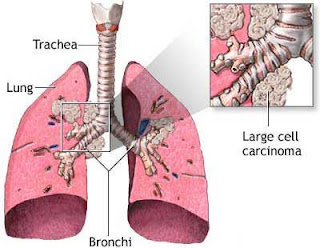Pulmonary tuberculosis is a disease of chronic bacterial infection caused by mycobacterium tuberculosis, an acid-fast bacilli are transmitted through the air. The disease is characterized by granuloma formation in infected tissues.
Patients with tuberculosis in the Asian region continues to grow. So far, Asia including the region with the highest spread of tuberculosis in the world. Every 30 seconds, there was one patient in Asia died from the disease. Eleven of the 22 countries with the highest numbers of TB cases are in Asia, including Bangladesh, China, India, Indonesia, and Pakistan. Four of five patients with TB in Asia, including the productive age group.

Etiology
Tuberculosis is caused by TB germs are mycobacterium tuberculosis measuring 0.3 x 2-4 cm. The nature of this bacteria is aerobic is more like living in a high tissue oxygen levels and also in cells that are dormant bacilli is not active but if the bacilli out of the cell will proliferate, the patient will experience a recurrence. Germs more resistant to acid more and more resistant to chemical and physical disorders, can not be seen by the naked eye, die in boiling water, easily killed when exposed to sunlight, survival in a humid room, can multiply in the cells (intra-cell and outside cell / extracellular). There are several factors that can influence the occurrence of TB infection, malignancy Namely tuberculosis bacillus. The number of bacilli are quite a lot, the source of infection, decreased body resistance caused by several factors of heredity, age, poor nutrition and diabetes mellitus.
Signs and Symptoms
A. Fever
Subfebris resemble influenza are fever, but sometimes the heat loss can reach 40-41° C. The first fever attack may recover briefly, but then can come back. This situation is greatly influenced by the immune system of patients and severity of infection of tuberculosis germs that enter.
B. Coughing / coughing up blood
Coughing occurs because of irritation of the bronchi, the nature of starting from dry cough (non - productive) then after the onset of inflammation to be productive (produces sputum). Circumstances are such as cough up blood occurs cavity, but the data also occur in the bronchial wall ulceration.
C. Asphyxiate
In bringan disease (emerging) has not felt shortness of breath. Shortness of breath will be found in the disease is advanced, which already includes the infiltration of the lungs.
D. Chest pain
Chest pain occurs when infiltration had come to the pleura, giving rise to pleurisy. Both pleural friction occurs when patients withdraw or release the breath.
E. Malaise
Symptoms of malaise found in the form of intake is inadequate, the more lean body, headache, chills, muscle aches, night sweats, etc.. Increasingly severe symptoms of this malaise is intermittent and occurs regularly.
Complications
Patients with tuberculosis in the Asian region continues to grow. So far, Asia including the region with the highest spread of tuberculosis in the world. Every 30 seconds, there was one patient in Asia died from the disease. Eleven of the 22 countries with the highest numbers of TB cases are in Asia, including Bangladesh, China, India, Indonesia, and Pakistan. Four of five patients with TB in Asia, including the productive age group.

Etiology
Tuberculosis is caused by TB germs are mycobacterium tuberculosis measuring 0.3 x 2-4 cm. The nature of this bacteria is aerobic is more like living in a high tissue oxygen levels and also in cells that are dormant bacilli is not active but if the bacilli out of the cell will proliferate, the patient will experience a recurrence. Germs more resistant to acid more and more resistant to chemical and physical disorders, can not be seen by the naked eye, die in boiling water, easily killed when exposed to sunlight, survival in a humid room, can multiply in the cells (intra-cell and outside cell / extracellular). There are several factors that can influence the occurrence of TB infection, malignancy Namely tuberculosis bacillus. The number of bacilli are quite a lot, the source of infection, decreased body resistance caused by several factors of heredity, age, poor nutrition and diabetes mellitus.
Signs and Symptoms
A. Fever
Subfebris resemble influenza are fever, but sometimes the heat loss can reach 40-41° C. The first fever attack may recover briefly, but then can come back. This situation is greatly influenced by the immune system of patients and severity of infection of tuberculosis germs that enter.
B. Coughing / coughing up blood
Coughing occurs because of irritation of the bronchi, the nature of starting from dry cough (non - productive) then after the onset of inflammation to be productive (produces sputum). Circumstances are such as cough up blood occurs cavity, but the data also occur in the bronchial wall ulceration.
C. Asphyxiate
In bringan disease (emerging) has not felt shortness of breath. Shortness of breath will be found in the disease is advanced, which already includes the infiltration of the lungs.
D. Chest pain
Chest pain occurs when infiltration had come to the pleura, giving rise to pleurisy. Both pleural friction occurs when patients withdraw or release the breath.
E. Malaise
Symptoms of malaise found in the form of intake is inadequate, the more lean body, headache, chills, muscle aches, night sweats, etc.. Increasingly severe symptoms of this malaise is intermittent and occurs regularly.
Complications
- Complications are often experienced by people with TB are as follows:
- Hemoptysis
- Collapse of the lobe
- Pneumothorax
- Pleural effusion
- Bronchiectasis
- Fibrosis
- The spread of infection to other organs such as brain, bones, joints, kidneys, and others.
- Cardio pulmonary insufficiency or decreased function of the heart and lungs so that oxygen levels in the blood is low.



